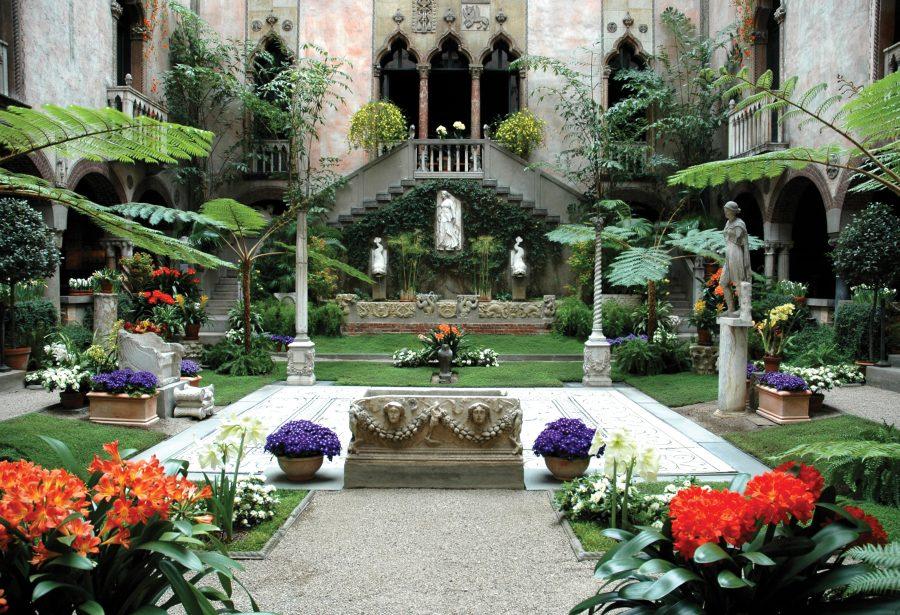“Fenway Court,” as the Isabella Stewart Gardner Museum was once called during it’s creator’s lifetime, exists as one woman’s idea manifested in what is today one of the most intriguing and thoughtful museums in the world. The Gardner Museum, which was originally opened to the public on Feb. 23, 1903, has once again been reopened on Jan. 19.
This newest beginning comes after extensive renovations to the museum’s beloved Tapestry Room and of course the addition of award-winning Italian architect Renzo Piano’s new wing.
When it came to creating something for The Gardner Museum (considered a work of art in itself) Piano proclaimed, “For The Gardner, we need to create magic.” And magic indeed was created. Museum director Anne Hawley raved in her speech at the opening ceremonies on Jan. 19, that Piano’s new building turned out “even better than we could have dreamed.”
Barbara Hostetter, president of the board of trustees at The Gardner, declared in her own speech that the new building was a work that took “12 years of thoughtful planning, design and execution” and was “inspired by the legacy of Isabella Stewart Gardner and the loyalty of our visitors.” With this new wing Hostetter says with confidence that the museum will be “ensured for generations to come.”
Having been called a “fragile historic palace,” The Gardner Museum, which was modeled after a 15th century Venetian palace, had an annual visitation rate that had gone from 2,000 people a year to 200,000. Director Hawley declared that the original building had been “overused, [and that] too many things had been shoe-horned into it.”
Thus it eventually became obvious that the museum had outgrown itself and that the stress of everything on the building would eventually become too much unless changes were made. The original building was never meant to house a gift shop, and the grand Tapestry Room was never meant to have its art pushed to the sides in order to make room for everything from lectures to orientations to the museum’s Sunday Concert Series.
The $114 million dollar, 70,000 square foot addition can now be found where the demolished carriage and green houses (added on in 1933) once stood. Certified green by the U.S. Green Building Council, the sustainable design includes everything from a geothermic well system, to daylight harvesting and water-efficient landscaping. The construction even included local materials in its production so as to reduce the impact that transporting these materials from elsewhere would have on the environment.
The new structure includes the innovative four floor, 300-seat “Calderwood” performance hall (front-row seating around a central stage), exhibition galleries, conservation labs, green houses, a horticulture classroom, and apartments for their “Artist/Scholar in residence” program among other things.
Former Public Program Assistant at the museum and recent Umass Boston graduate, Lilly O’Flaherty, attended the opening ceremonies and concert in the new Calderwood Hall and called the space, “completely intimate”, adding that the way it is set up “the audience is facing in, looking at each other as well as the musicians, [so] there is a feeling of connectedness, of a shared experience.”
Of course it was preservation that stood at “the heart of the museum’s plans for the new extension” and preservation was also the focus for the restoration of the museum’s Tapestry Room. Along with the addition of the new wing, the 4,000 square foot room has been restored to its original function and to Isabella’s original positioning of the art.
Although stated in Isabella’s will that after her death everything in the museum remain as she had it organized and nothing be moved, the Tapestry Room had been altered in the 1970s to serve as a music room of sorts- the justification behind this that it had actually been a two-floor music hall until 1914.
Using archival photographs the room now stands as it did at its creation, with its tile flooring cleaned and polished, its furniture regaining its original positioning, and lighting added to make for better display of the tapestries. Also, since the visitor amenities are now separate from the palace, “the experience of visiting the museum feel[s] more authentic and magical,” O’Flaherty claims.
The new and old buildings at The Gardner Museum seem somehow beautifully juxtaposed and somehow both compatible and incompatible at the same time. Hawley says that Piano’s building was meant to be more of a “companion building” so as not to take away from the original structure.
From this partner building’s mostly glass siding can be seen almost fully the original “Fenway Court,” and as one travels through the 50-foot glass hallway that connects the two together, one eventually enters the intricate and captivating 109-year-old museum.
Isabella Stewart Gardner left for us over 2,500 paintings, sculptures, tapestries, furniture, rare books and more with masterpieces from artists such as Michelangelo, John Singer Sargent, Titian, and Rembrandt among others. All of these according to her will, “for the education and enrichment of the public forever.” Renzo Piano’s new building now makes certain that we shall enjoy these gifts for many more years to come.
The Isabella Stewart Gardner Museum is located at 280 The Fenway, Boston and is open Wednesday through Monday from 11 a.m. – 5 p.m. and Thursdays until 9 p.m. Admission is $5 for college students with valid ID. For more information visit www.gardnermuseum.org.






















































